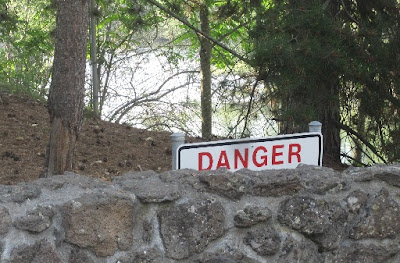 |
| What Is It? |
The Helena Brewers stadium, like many of the parks in the Mountain West, is pretty old, small, and amenity-free. I really liked it. I've come to appreciate the smaller, often less affluent towns where the games are clearly part of the everyday fabric of summer life. It's always more comfortable to sit in a nicer, newer park, of course, but there's something a little fake about it. Fort Wayne has a whiff of astroturf; Helena is truly grassroots. We were there a few days before Brewers first baseman David Denson came out as gay, to national notice, so we didn't see what sort of response he got in his first game thereafter. I'd like to think it was no big deal.
 |
| Give me this over where the White Sox play any day. |
Speaking of heartbeats, ours were pounding a little as we spent a couple hours driving through areas that were literally on fire. As you may or may not have known, forest fires were ravaging this part of the country at that time. In addition to not-so-distant plumes...
 |
| all smoke and alligator photos by Rob |
We powered on through Lewistown, Clarkston, and smaller outposts, intent on not leaving Watson waiting at our hotel in the middle of Columbia River any longer than necessary. (That's the best thing about that place, by the way.) We did stop to size up some roadside metal animals, of course:
After mediocre beer and lunch at Ice Harbor and some provisioning for the next day's adventure, we crossed the river to Pasco for the tilt between the Tri-City Dust Devils and the Boise Hawks. This was another low-rent but quietly perfect stadium. Tiring, as one does, of sitting too close to thick nets, we moved up higher into the less-populated regions of the stands, where I slouched so precariously as to lose my wallet. (Being a super-genius, I did not realize this until after we'd gone all the way back to the mid-river hotel; with Watson's critical assistance, we raced back to the darkened park, where luckily a lingering employee cheerily saved the night.)
 |
| Have I mentioned that not only do I not want nets extended for "the safety of the fans," I want them abolished altogether? |
All this is mere prelude, however, to the real highlight of our visit to the Tri-Cities. "But wait, Melvin," you might be thinking, "you've mentioned Kennewick and Pasco, but what's the rest of the trinity?" Well, it ain't the Trinity Site, but now we're on the right track....
Thursday dawned with a salty and so-so breakfast at the JD Diner in Richland, but the bulk of it was taken up with a five-hour tour of the Hanford Site, where America manufactured its plutonium. This enormous site has a complex history, but the short of it for present purposes is that whether or not you think developing nuclear weaponry was a good idea, the people who did it here were learning as they went, with inarguably catastrophic results for the local environment. Prior to Hanford's creation, no one had ever built a nuclear reservation before, so many decisions that proved to be unwise in the long run were made. To this day, Hanford is one of the most radioactively toxic places in the world, and—as we discovered—even the tour guides, who in general are trying to make people feel comfortable about what has transpired out there, aren't perfectly clear on the extent of the damage to both the place and the people who have worked there. (There are many books on Hanford; I recommend Kate Brown's Plutopia more than most of them.)
 |
| Hanford B Reactor, 1940s Image: U.S. Department of Energy |
 |
| "B Reactor Process Tube Nozzles" by Shane Lin used through Creative Commons license |
By the end of the tour we had lost most of whatever confidence we had had in science, the government, and the future. Somewhat numbed, we drove on to Spokane.
 |
| A relic from the Computer Museum in Bozeman, but so much more appropriate here. |
 |
| photo by Rob, as are the next two |
The remains of Expo 74 are here, including the United States Pavilion:
Have you ever heard "Yes, You Can In Spokane," written by a fellow named Reg Fulton? Well, here's your chance, as performed by Bob Bellows, International Pianist:
Personally, I will always treasure having seen Rob's delight at spotting a modernist parking garage. Had he been plucked away by aliens for an eternity of interstellar psychosexual torture at this exact moment, I think he would have looked back fondly at his last moments on Earth:
At last, baseball! Spokane has another of those lovely parks, like Helena, where the amenities aren't all they might be, but the ambience can't be beat. Avista Stadium dates to 1958, and I like it better than Dodger Stadium, which is roughly the same vintage. (This is possibly in part because I was not sopping wet in Spokane.)
We watched the Indians tilt with the Salem-Keizer Volcanoes, picked up some Salish-language swag, and then wrapped up the evening with a visit back to Riverfront Park to experience the grandeur of Spokane Falls. It was nice to end a couple days marked by burning trees, atoms, and tempers with some contemplation of water.
 |
| From The Great Northwest, 1888; via Wikipedia |








No comments:
Post a Comment